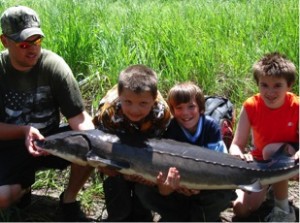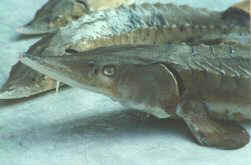
Photo: Michigan State University.
Researchers at Michigan’s Black Lake are studying threats to sturgeon and using their findings to teach biology to students from kindergarten through high school.
Threatened
Among the questions examined at the lake near the tip of the state’s Lower Peninsula is why the prehistoric fish hasn’t reproduced in the wild as much as scientists would like.
There are some working hypotheses, said Edward Baker, the co-principal investigator on the project. One is that the habitat isn’t ideal.
“The habitat has changed sufficiently from what it was before Europeans extensively settled the state that the larvae, once they hatch and start to grow, just aren’t surviving,” said Baker, who is the lake sturgeon coordinator at the Department of Natural Resources
“Pollution and water quality issues were probably a problem back around the turn of the century when the sturgeon initially declined,” he said.
Nowadays we’re not polluting as much and water quality is much better. The biggest habitat challenge is that many of the rivers the sturgeon use to spawn have dams.
Dams change a river’s flow and block traditional spawning grounds. Complicating the matter is the sturgeon’s unique reproduction, said Kim Scribner, co-principal investigator on the project.
When most people think of fish, they think of those species that make nests; where an area is carved out, the female lays the eggs, the male fertilizes them and there is some level of parental care, said Scribner, who is a fisheries and wildlife professor at Michigan State University.
But sturgeon release sperm and eggs that are distributed over very large areas of water, he said. “It’s a very inefficient system. It requires a lot of individuals.”
With fewer fish, the process is even less efficient. Sturgeon require up to 20 years to reach sexual maturity.
Invasive species may also be a persistent problem, Scribner said. “One of the largest predators of larvae and juvenile lake sturgeon are invasive rusty crayfish. They are voracious predators on sturgeon even at older age levels where the individuals are large enough to be beyond the threat of predation by most fish predators.”
But the researchers aren’t letting sturgeon go down without a fight. They also run a sturgeon hatchery near the lake. Research there is informing how genetic diversity may help preserve the species, said Dave Borgeson, supervisor for the Northern Lake Huron Management Unit of the Department of Natural Resources fisheries division.
If there’s a lot of genetic diversity in a population, it allows that population to respond quicker and better to a change in the environment, Baker said. If a population is very close genetically, it could be very susceptible to a particular disease that could wipe out a whole population.
From lake and lab to classroom

A young sturgeon. Photo: U.S. Fish and Wildlife Service.
The project also develops K-12 curricula that are derived from actual data gathered on sturgeon. The study’s website has lesson plans that educators have used in their own science classes.
For Scribner, it’s about giving students an experience with real biology.
“Kids can get really excited learning about science, technology, engineering and math types of work but in the context of a very charismatic species,” Scribner said. The sturgeon, with its huge, 6-foot body and shark-like tail, inspires students to look into the data and interpret graphs to see what they say about the sturgeon and their environment.
Lesson plans include instructions on the scientific method, egg survival, juvenile capture and spawning behavior.
Beyond the science, the classes also instill children with a sense of attachment to the environment, and as future voters, a sense of responsibility.
“I don’t think its any secret that, over time, we’re becoming a more urbanized society and students are less and less exposed to the natural world,” Baker said. “I think it’s important to give students an understanding that there is a natural world around them that does provide benefits for us and if we don’t take care of it, those benefits will disappear.”
The project is funded by the U.S. Fish & Wildlife Service through the Great Lakes Restoration Initiative.
Sturgeon eggs attach to the tops of rocks. Gobies have a suction cup on thier chest for hanging onto rocks in current. gobies eat eggs, and are spreading thoughout our rivers. I asked a Sturgeon guy, I believe his name was Veche. Gave a talk about Muskegon river sturgeon.Other fish have always eaten eggs, part of nature, more egg eaters bad for all native fish.
To Tom H,
You do know that both PI’s quoted are NOT Sturgeon for Tomorrow people…they are Michigan State or Michigan DNR employees. Sturgeon for Tomorrow is a valuable asset to the community; however, they are also NOT “operating their sturgeon hatchery…” That would also be Michigan DNR and Michigan State University students. Just some clarification…
The Sturgeon For Tomorrow organization has done a fantastic job to be proud of! They are protecting the spawning adults, operating their sturgeon hatchery, and are now a strong supporting organization with other tribal biologist, DNR hatchery biologists, and interstate governments operating several mobile hatcheries on several other major rivers to the Great Lakes. We need to support the GLRI funding to continue the dam removal projects needed by all the native fisheries including the sturgeon.
Here’s a quote from the program’s website (accessed through the link):
“Lake sturgeon have a low reproductive rate and may not begin to spawn until they are 15-25 years old. Male lake sturgeon reach sexual maturity at 15-20 years of age, and males spawn on average every other year. Once females mature at about 20-25 years of age, they spawn on average every three to four years. These characteristics reduce the rate of recovery of lake sturgeon, which has been designated as a protected species throughout much of their native range.”
Lake Sturgeon are listed as a Threatened species in Michigan, still dangerously close to extinction. In order for the “rate of recovery” to increase, first and foremost we should stop killing them. That just seems to be common sense.
Invasive species may be a persistant problem. Yes they may be just that.